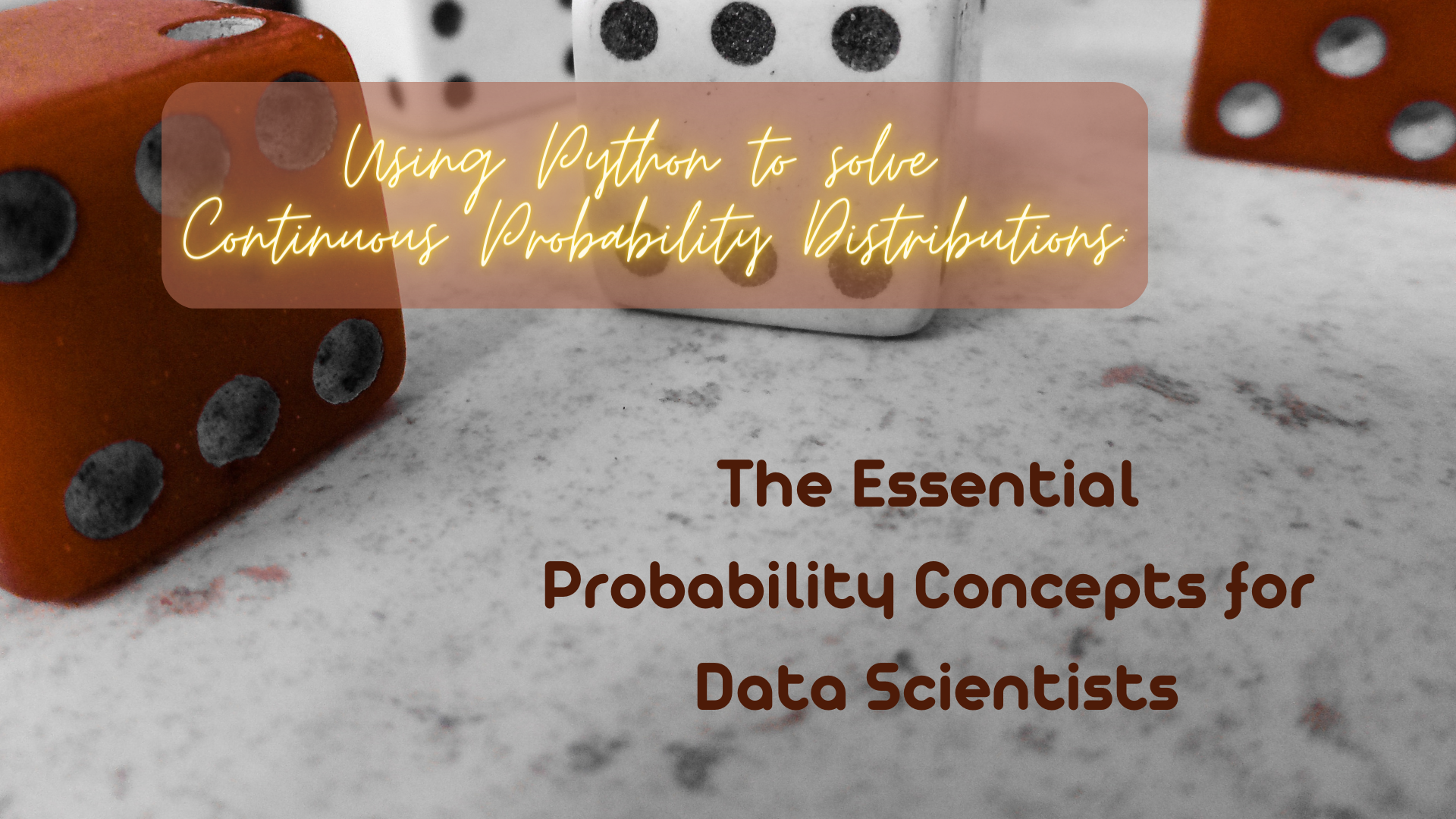Solving Continuous Probability Distributions with Python: A Complete Guide
 Smart Shock
Smart Shock
Introduction
Continuous probability distributions play an important role in statistical analysis and data science. They are used to model the distribution of continuous random variables and can provide insights into the behavior of real-world phenomena. In this blog post, we will explore how to solve problems using some commonly used continuous probability distributions - normal, exponential, uniform, and gamma distribution. We will also provide distinct exercises to differentiate the use of different distribution functions and explain when to apply which. Finally, we will solve each problem using Python.
Normal Distribution
The normal distribution is a widely used continuous probability distribution that describes a symmetrical bell-shaped curve. It is often used to model real-world phenomena that are normally distributed, such as IQ scores, heights, and weights. The distribution is characterized by its mean and standard deviation.
Exercise:
The average height of a population of men is 178 cm with a standard deviation of 7 cm. What is the probability of selecting a man at random who is between 170 cm and 185 cm tall?
Solution:
To solve this problem, we need to calculate the area under the normal distribution curve between 170 cm and 185 cm. We can use the cumulative distribution function (CDF) of the normal distribution to do this. In Python, we can use the scipy.stats.norm module to work with the normal distribution.
import scipy.stats as stats
# Mean and standard deviation of the distribution
mu = 178
sigma = 7
# Probability of selecting a man between 170 cm and 185 cm tall
prob = stats.norm.cdf(185, mu, sigma) - stats.norm.cdf(170, mu, sigma)
print("The probability of selecting a man between 170 cm and 185 cm tall is", prob)
Output
The probability of selecting a man between 170 cm and 185 cm tall is 0.7147957915949852
Exponential Distribution
The exponential distribution is a continuous probability distribution that describes the time between two successive events in a Poisson process. It is often used to model the time between arrivals of customers, failures of machines, and radioactive decay. The distribution is characterized by its rate parameter, which is the average number of events per unit time.
Exercise:
The average time between two customer arrivals at a store is 10 minutes. What is the probability that the time between two arrivals is less than 5 minutes?
Solution:
To solve this problem, we need to calculate the area under the exponential distribution curve between 0 and 5 minutes. We can use the CDF of the exponential distribution to do this. In Python, we can use the scipy.stats.expon module to work with the exponential distribution.
import scipy.stats as stats
# Rate parameter of the distribution
lam = 1 / 10 # The average time between two customer arrivals
# Probability that the time between two arrivals is less than 5 minutes
prob = stats.expon.cdf(5, scale=1/lam)
print("The probability that the time between two arrivals is less than 5 minutes is", prob)
Output
The probability that the time between two arrivals is less than 5 minutes is 0.3934693402873666
Uniform Distribution
The uniform distribution is a continuous probability distribution that describes a constant probability of any value within a certain range. It is often used to model phenomena that are equally likely to occur within a given range, such as rolling a fair die or selecting a random number between two values. The distribution is characterized by its minimum and maximum values.
Exercise:
A company sells widgets that are priced between $10 and $20. What is the probability that a customer selects a widget priced between $12 and $15?
Solution:
To solve this problem, we need to calculate the area under the uniform distribution curve between $12 and $15. We can use the PDF of the uniform distribution to do this. In Python, we can use the scipy.stats.uniform module to work with the uniform distribution.
# import necessary libraries
import scipy.stats as stats
# set up the parameters for the uniform distribution
a = 10 # lower bound of prices
b = 20 # upper bound of prices
# create a uniform distribution object
uniform_dist = stats.uniform(loc=a, scale=b-a)
# calculate the probability of selecting a widget priced between $12 and $15
prob = uniform_dist.cdf(15) - uniform_dist.cdf(12)
# print the probability
print("The probability of selecting a widget priced between $12 and $15 is:", round(prob, 2))
Output
The probability of selecting a widget priced between $12 and $15 is: 0.3
Gamma Distribution
The gamma distribution is a continuous probability distribution that describes the waiting time for a certain number of events in a Poisson process. It is often used to model the time until the first failure of a machine or the time until a certain number of customers have arrived at a store. The distribution is characterized by its shape and rate parameters.
Exercise:
The average time until the first failure of a machine is 500 hours, and the shape parameter of the gamma distribution is 2. What is the probability that the machine fails before 1000 hours?
Solution:
To solve this problem, we need to calculate the area under the gamma distribution curve between 0 and 1000 hours. We can use the CDF of the gamma distribution to do this. In Python, we can use the scipy.stats.gamma module to work with the gamma distribution.
import scipy.stats as stats
# Shape and rate parameters of the distribution
k = 2
theta = 500
# Probability that the machine fails before 1000 hours
prob = stats.gamma.cdf(1000, a=k, scale=theta)
print("The probability that the machine fails before 1000 hours is", prob)
Output
The probability that the machine fails before 1000 hours is 0.5939941502901616
When to Apply Which Distribution?
Normal Distribution:
Use the normal distribution to model phenomena that are normally distributed, such as IQ scores, heights, and weights.
Exponential Distribution:
Use the exponential distribution to model the time between two successive events in a Poisson process, such as the time between arrivals of customers or the time between failures of machines.
Uniform Distribution:
Use the uniform distribution to model phenomena that are equally likely to occur within a given range, such as rolling a fair die or selecting a random number between two values.
Gamma Distribution:
Use the gamma distribution to model the waiting time for a certain number of events in a Poisson process, such as the time until the first failure of a machine or the time until a certain number of customers have arrived at a store.
Exercises
Here are some exercises for each topic:
Normal Distribution Exercises:
a) The average height of a group of people is 170 cm with a standard deviation of 10 cm. What percentage of people have a height between 160 cm and 180 cm?
b) The average weight of a group of people is 70 kg with a standard deviation of 5 kg. What percentage of people weigh less than 60 kg?
c) The average IQ score is 100 with a standard deviation of 15. What percentage of people have an IQ score between 85 and 115?
Exponential Distribution Exercises:
a) The average time between arrivals of customers at a store is 5 minutes. What is the probability that the next customer arrives within the next 2 minutes?
b) The average time between failures of a machine is 100 hours. What is the probability that the machine will fail within the next 50 hours?
c) The average waiting time for a bus is 15 minutes. What is the probability that you will have to wait less than 10 minutes for the next bus?
Uniform Distribution Exercises:
a) A fair die is rolled. What is the probability of rolling a number greater than 4?
b) A customer can select any number between 1 and 100 on a lottery ticket. What is the probability of selecting a number between 25 and 50?
c) A company produces widgets with a weight between 10 and 20 grams. What is the probability of producing a widget with a weight between 15 and 18 grams?
Gamma Distribution Exercises:
a) The average time until the first failure of a machine is 500 hours, and the shape parameter of the gamma distribution is 2. What is the probability that the machine fails before 1000 hours?
b) The average time until a customer arrives at a store is 10 minutes, and the shape parameter of the gamma distribution is 3. What is the probability that a customer arrives within the next 5 minutes?
c) The average time until a student completes an exam is 60 minutes, and the shape parameter of the gamma distribution is 4. What is the probability that a student completes the exam in less than 30 minutes?
Conclusion
In conclusion, continuous probability distributions play an important role in statistical analysis and data science. In this blog post, we have explored how to solve problems using the normal, exponential, uniform, and gamma distributions. We have also provided distinct exercises to differentiate the use of different distribution functions and explained when to apply which. Finally, we have solved each problem using Python, which is a powerful tool for working with probability distributions.
Subscribe to my newsletter
Read articles from Smart Shock directly inside your inbox. Subscribe to the newsletter, and don't miss out.
Written by
